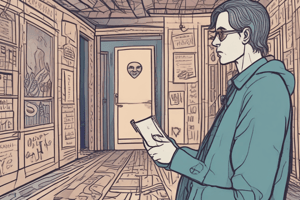Podcast
Questions and Answers
What is a characteristic of depressive symptoms in a specific disorder?
What is a characteristic of depressive symptoms in a specific disorder?
- Patients develop symptoms in the morning
- Patients develop symptoms during winter seasons with decreased daytime (correct)
- Patients develop symptoms during summer seasons
- Patients develop symptoms at night
What is the range of lux used in phototherapy for depression?
What is the range of lux used in phototherapy for depression?
- 500-1000 lux
- 10000-20000 lux
- 1500-10000 lux (correct)
- 20000-50000 lux
What score range indicates a high risk on the SADPERSONS scale?
What score range indicates a high risk on the SADPERSONS scale?
- 5-6
- 11-15
- 7-10 (correct)
- 0-4
What is a relative contraindication for Electroconvulsive therapy (ECT)?
What is a relative contraindication for Electroconvulsive therapy (ECT)?
What is a common side effect of Electroconvulsive therapy (ECT)?
What is a common side effect of Electroconvulsive therapy (ECT)?
What factor decreases the seizure threshold in Electroconvulsive therapy (ECT)?
What factor decreases the seizure threshold in Electroconvulsive therapy (ECT)?
What is the primary use of Phototherapy for depression treatment?
What is the primary use of Phototherapy for depression treatment?
What does a score of 0-4 indicate on the SADPERSONS scale?
What does a score of 0-4 indicate on the SADPERSONS scale?
What is an indication for Electroconvulsive therapy (ECT)?
What is an indication for Electroconvulsive therapy (ECT)?
What is a mechanism of action of Electroconvulsive therapy (ECT)?
What is a mechanism of action of Electroconvulsive therapy (ECT)?
Flashcards are hidden until you start studying
Study Notes
SADPERSONS Scale for Suicidal Evaluation
- The SADPERSONS scale is used to assess suicide risk, with 10 yes/no questions, each scoring 1 point for affirmative answers.
- The score is then mapped to a risk assessment scale:
- 0-4: Low risk
- 5-6: Medium risk
- 7-10: High risk
Electroconvulsive Therapy (ECTs)
- Indications for ECTs:
- Severe depressive disorder unresponsive to antidepressants
- Life-threatening depressive illness (high suicide risk)
- Stupor or catatonia
- Marked psychomotor retardation
- Psychotic depression
- Treatment-resistant mania
- Treatment-resistant schizophrenia
- Relative contraindications:
- Raised intracranial pressure
- Myocardial infarction
- Valvular heart diseases
- Aneurysm
- Recent stroke
- Severe peptic ulcer (increased risk of aspiration)
- Mechanism of action:
- Release of noradrenaline, serotonin, and dopamine, with reduction of acetylcholine release
- Increase in blood-brain barrier permeability
- Modulation of neurotransmitter receptors (e.g., GABA, acetylcholine)
- Side effects:
- Common: headache, muscle pain, jaw pain, drowsiness, loss of recent memories (retrograde amnesia), anterograde amnesia
- Less common: prolonged seizures, confusion, anesthesia complications, arrhythmia, pulmonary embolism, and aspiration pneumonia
- Factors affecting seizure threshold:
- Increase: old age, male gender, baldness, Paget's disease, dehydration, previous ECT, and benzodiazepine treatment
- Decrease: caffeine, low CO2 saturation, hyperventilation, and ECT
Phototherapy for Depression
- Primarily used for seasonal affective disorders (mood disorder with seasonal pattern)
- Involves exposure to bright light (1500-10,000 lux or more)
- Often used in combination with pharmacotherapy and psychotherapy
Learning Disorders (Specific Developmental Disorders of Scholastic Skills)
- Characterized by significant impairment in one or more scholastic skills, out of proportion to intellectual functioning
- Subtypes include:
- Specific reading disorder (dyslexia): impaired reading performance, with errors, slow reading speed, or comprehension difficulties
- Disorder of written expression (specific spelling disorder): frequent spelling mistakes, errors in grammar and punctuation, and poor handwriting
- Specific disorder of arithmetic skills: impaired arithmetic skills
- Mixed disorders of scholastic skills: impairment in reading, writing, and arithmetic combined
- Associated problems may include inattention, hyperactivity, and emotional disturbances
Studying That Suits You
Use AI to generate personalized quizzes and flashcards to suit your learning preferences.




